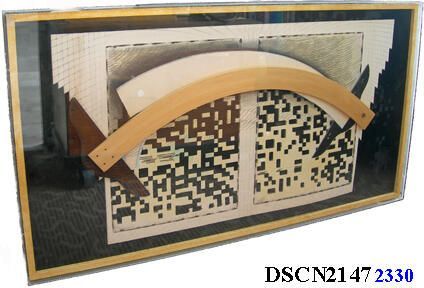C-Square with drawing

C-Square with drawing
The wooden C-square was the progenitor of all variations in the "square" series. This was the initial notion of a bent T-Square I made reflecting on Buckminster Fuller's books and lectures. He made me question the prevalence of the post-and-lintel principles in a building. His geodesic theories - many of which he applied - suggested there are other construction principles and these are drawn from natural sources. I pinned a piece of paper on a wall at old Triangle Studios and, holding a pencil I swung my hand from my elbow and drew an arc. Then I let it be that this was easier than drawing a straight line, therefore it might be more natural. Owing to Fuller's idea that such natural orders might coexist with "right-angle thinking," I thought of T-Squares and this drawing became the plan for my first "C-Square." Fast forward a few years, I was invited to participate in a show at the Henry Gallery and I wanted to show the C-Square. Thinking the director and curators might question the validity of this odd, curved T-Square, I mounted it on a panel (it had been my inking counter for years and had a nice patina of etching ink) and this over the original drawing. Mounted in an acrylic frame, it looked more like a work of art and it showed at the Henry Gallery this way. Later I added screen-printed squares because my work in computer graphics was taking hold, and I liked the pixellated effect of those black squares.
